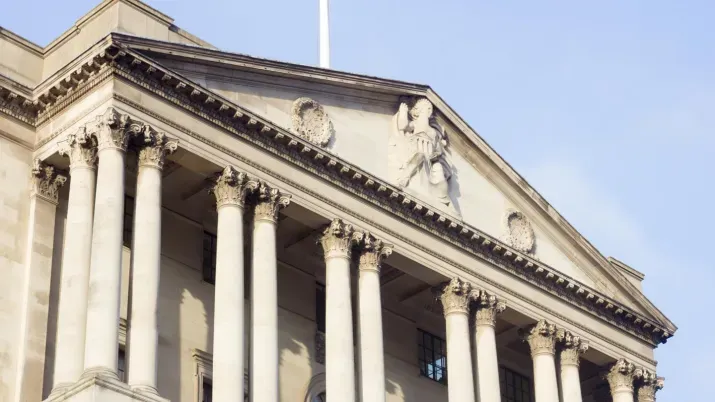Flash Fixed Income: Is term premium back?
TwentyFour
Key takeaways
- US Treasury yields have risen more aggressively at the start of this cutting cycle than in any other of the past 40 years, driven by sticky inflation and President Trump’s emerging policy agenda.
- Estimates of term premium have also increased markedly over the past few months as markets price in factors such as higher inflation volatility and increased supply of US Treasuries.
- Our view is that Trump’s impact on the US deficit may not be as severe as pre-election forecasts, and that despite the noise around tariffs, housing and wages remain the key inflation drivers to watch.
Since September 18 the Federal Reserve (Fed) has cut interest rates by 100 basis points (bp), but the 10-year US Treasury yield has risen by 80bp (it was almost 100bp higher in mid-January).
While unusual, an increase in yields as a cutting cycle begins is not without historical precedent, with three of the past six US cutting cycles seeing flat or higher 10-year yields in the three months after the first cut (absent a market shock the first cut tends to be well priced in). However, the Fed’s latest cutting cycle has seen the most aggressive rise in bond yields of any cutting cycle over the past 40 years (see Exhibit 1).
There have been a number of drivers behind this unusual rise in yields since the Fed’s first rate cut, three of which are well documented.
First, labour market fears have faded. Shortly before the September 17-18 meeting the US unemployment rate had unexpectedly jumped from 4.1% to 4.3%. This sudden deterioration saw 10-year yields rally from 3.9% to just over 3.6% between August 30 and September 16, while the Fed cut by 50bp and raised its forecast for end-2024 unemployment rate to 4.4%, up from the 4.0% it had set just three months before. Since that meeting, however, the labour market panic has receded. The unemployment rate fell to 4.1% in October and stayed there until year-end.
Second, inflation data has been stronger than expected. Core Consumer Price Index (CPI) inflation ran at 0.3% month-on-month in September, October and November, fell to 0.2% in December but then reaccelerated to 0.4% in January, putting the annual rate at 3.3% in January versus an expected 3.1%. At its September meeting the Fed had published an end-2024 projection of 2.6% year-on-year for its preferred Core Personal Consumption Expenditures (PCE) index, but that measure rose to 2.8% in October and remained there until year-end.
Third, Donald Trump returned to the White House. As his comfortable victory became increasingly apparent on election day, the market reaction was a sharp increase in US Treasury yields and a bear steepening of the curve. The likely result of a second Trump term was widely regarded to be higher growth, higher inflation and a higher deficit (the Committee for a Responsible Federal Budget’s pre-election base case was for a $7.5tr increase through to 2035). The inflation and deficit fears have persisted in the months since Trump’s victory, combined with a Fed that has leant more hawkish given the data trends described above. 10-year inflation breakevens have risen, though they remain within the range of the past two years at around 2.4%, and real yields have also risen to 2.05% from around 1.58% in September.
Is term premium driving yields higher?
One less well-documented driver, however, is that estimates of term premium have increased markedly over the past few months to new cycle highs.
As a reminder, term premium is the extra compensation investors demand for holding longer-term bonds rather than rolling over a series of shorter-term bonds (one rough calculation is 10-year UST yields minus the average of expected T-bill yields over the next 10 years). Term premium is not directly observable and can only be estimated using econometric models, so we are wary of relying too heavily on forecasts for the level of term premium, which differs depending on the model.
What can be instructive however is the market’s estimation for the change in term premium over a particular time period, and the shift higher over the last couple of months has been sharper than at any point over the past five years (the dark green line in Exhibit 2).
There are a number of drivers that could explain this increase in term premium.
1. Higher inflation uncertainty
The most important secular driver of term premium is level-dependent inflation uncertainty. The high levels of inflation and inflation volatility in the 1980s, for example, drove inflation risk premiums of 3-4% within nominal yields before subsequently falling to virtually zero in the decades after. Given term premium estimates were around zero in the months leading up to Trump’s victory, the reset higher suggests a market acknowledgment that his second term will most likely lead to higher inflation volatility from a starting point that is already above target.
While we do not place too much weight on survey-based inflation expectations, it is worth noting that the University of Michigan year-ahead inflation survey published on February 7 spiked 100bp month-on-month and is now up almost 200bp since election day. Some of this will be due to higher US inflation prints since then, as well as higher oil prices, but interestingly the split between Democrat and Republican voters shows how narrative is also driving expectations; Democrat-voting inflation expectations spiked above 5%, while Republican-voting inflation expectations fell to close to 0%.
2. More Treasury supply
Supply and demand of government bonds is also a driver of term premium, and large deficit funding can weaken technical demand at the long end as the market is asked to take down more and more duration.
Given the $7.5tr deficit increase forecast pre-election, one can see how a nervousness around deficit spending in the future might translate into bond risk premiums. This premium embedded in nominal yields tends to be more pronounced when inflation levels are high and the fiscal situation is poor. While we would not necessarily characterise core PCE at 2.8% as especially “high”, particularly when compared to the persistence in both level and volatility in the 1980s, it is nevertheless higher than target and the Fed, as we have described, quite clearly thinks the risks to inflation are on the upside, while running a 6% deficit over the longer term is unsustainable (as Powell keeps highlighting in his press conferences).
3. Positive stock-bond correlations
Another major driver of term premium is the correlation between stocks and bonds, which could be described as the ability of the risk-free asset to hedge a risk-off event. Conceptually it makes sense that investors would be less willing to hold longer duration bonds if they thought that these bonds would be less likely to protect them in a recessionary scenario.
Stock-bond correlation was negative for much of the 2000s and 2010s after being positive for most of the period between the mid-1960s and the late 1990s, with the correlation being most positive in supply shock environments when economies can have both high unemployment and high inflation. In recent years we have seen that positive correlation return, most notably in 2022 when virtually all assets were selling off. The evidence of the past few years suggests that, while correlations have been positive between risk and risk-off assets, the market’s perception of risk-off assets as recession hedging tools had remained largely intact, given deeply inverted yield curves and little to no term premium.
However, we would argue that the "safe haven" premium within bonds has not been truly tested in recent years given the very strong growth backdrop. While we do not doubt the ability of bonds to act as the "risk-off" asset if growth was to truly slow, recent positive correlations could be driving investors to demand more of a premium for the diminished diversification benefit of USTs.
Cautious optimism on the US deficit
While quantifying the various risk premiums described above is challenging, for fixed income investors there are a couple of considerations that help make the theoretical more practical.
In terms of the US deficit, we are cautiously optimistic that the increase will be less severe than expected. The new administration has given some early evidence that they are not going to increase fiscal spending with abandon. We can see the Department of Government Efficiency helping to cut the deficit, though by less than Elon Musk has pledged (he claims DOGE has already hit its $4bn/day target). In addition, new Treasury Secretary Scott Bessent has highlighted a number of times his “3/3/3” target of 3% real GDP growth, a 3m barrel a day increase in oil production and a 3% deficit. To be clear, we heavily discount any outlandish targets announced by the new administration (it is highly unlikely that DOGE has already cut the deficit by $1tr/year), but we think the deficit is front of mind for some key advisors to President Trump, as well as many Republican senators; whether this focus holds if the President’s priorities were to change is another matter.
The Treasury recently announced it intended to keep duration supply stable for the "next few quarters", which was more dovish than expected. This is important because the maturity profile of supply is more of a driver of risk premiums within nominal curves than the overall debt-to-GDP level, and Bessent said in a recent interview that both he and the President are targeting lower 10-year yields. We will also be keeping an eye on how easily the market is taking down new supply across maturity profiles, looking at the bid-to-cover ratio on new issuance as well as primary dealer splits.
For inflation, housing and wages trump tariffs
As we wrote in a blog last month (“Tariffs are the noise. Housing is the signal.”), we think housing and wages remain the key data points to watch as the underlying drivers of inflation, despite the noise around tariffs where headlines will certainly add to inflation volatility.
CPI ex-housing, both for headline and core, is roughly at the Fed's target on a YoY basis, and we expect continued disinflation in shelter CPI which operates with a significant lag (CoreLogic new rent growth was at a 14-year low of 1.5% in November). Immigration policy will be key to wage dynamics in the coming years. One thing that could change the Fed's view on whether the labour market is providing any upside inflation pressure is whether the Trump administration is able to take labour supply out of the market enough to tighten the labour market back to 2022 levels. The early signs are that this is unlikely, and that net immigration will fall but remain positive (Goldman Sachs estimates it will fall to around 750k a year), but it is something to keep a close eye on.
Ultimately, if we think of nominal yields as a function of future base rates plus a term premium, while understanding the drivers of term premium are important, the majority of moves in the long end can be defined by what happens in the short end. We can quantify this by looking at the change in terminal rate expectations; the market was pricing in a terminal rate (where rates bottom out in a given cycle) of around 2.75% in August 2024 as recession fears grew, but it has since removed almost 125bp of cuts with the implied terminal rate now just below 4%. While this is a little above our estimate of the neutral rate for the US, it looks more accurate now than it did back in August. We also think that given the central banks’ guidance of data dependence, volatility around future base rate forecasts will remain elevated. We will go through periods where the data is better and the market will underprice cuts, and we will go through periods where the opposite occurs. The trade of the last few years has been to fade either extreme.
Important Information: The views expressed represent the opinions of TwentyFour as at 13 February 2025, they may change, and may also not be shared by other members of the Vontobel Group. This article does NOT express any political views or endorsements, but rather aims to objectively analyse the economic factors and implications. The analysis is based on publicly available information as of the date above and is for informational purposes only and should not be construed as investment advice or a personal recommendation.
Any projections, forecasts or estimates contained herein are based on a variety of estimates and assumptions. Market expectations and forward-looking statements are opinion, they are not guaranteed and are subject to change. There can be no assurance that estimates or assumptions regarding future financial performance of countries, markets and/or investments will prove accurate, and actual results may differ materially. The inclusion of projections or forecasts should not be regarded as an indication that TwentyFour or Vontobel considers the projections or forecasts to be reliable predictors of future events, and they should not be relied upon as such. We reserve the right to make changes and corrections to the information and opinions expressed herein at any time, without notice.
Past performance is not a guarantee of future results. Diversification does not assure a profit or protect against loss in declining markets. Investing involves risk, including possible loss of principal. Value and income received are not guaranteed and one may get back less than originally invested. TwentyFour, its affiliates and the individuals associated therewith may (in various capacities) have positions or deal in securities (or related derivatives) identical or similar to those described herein.








